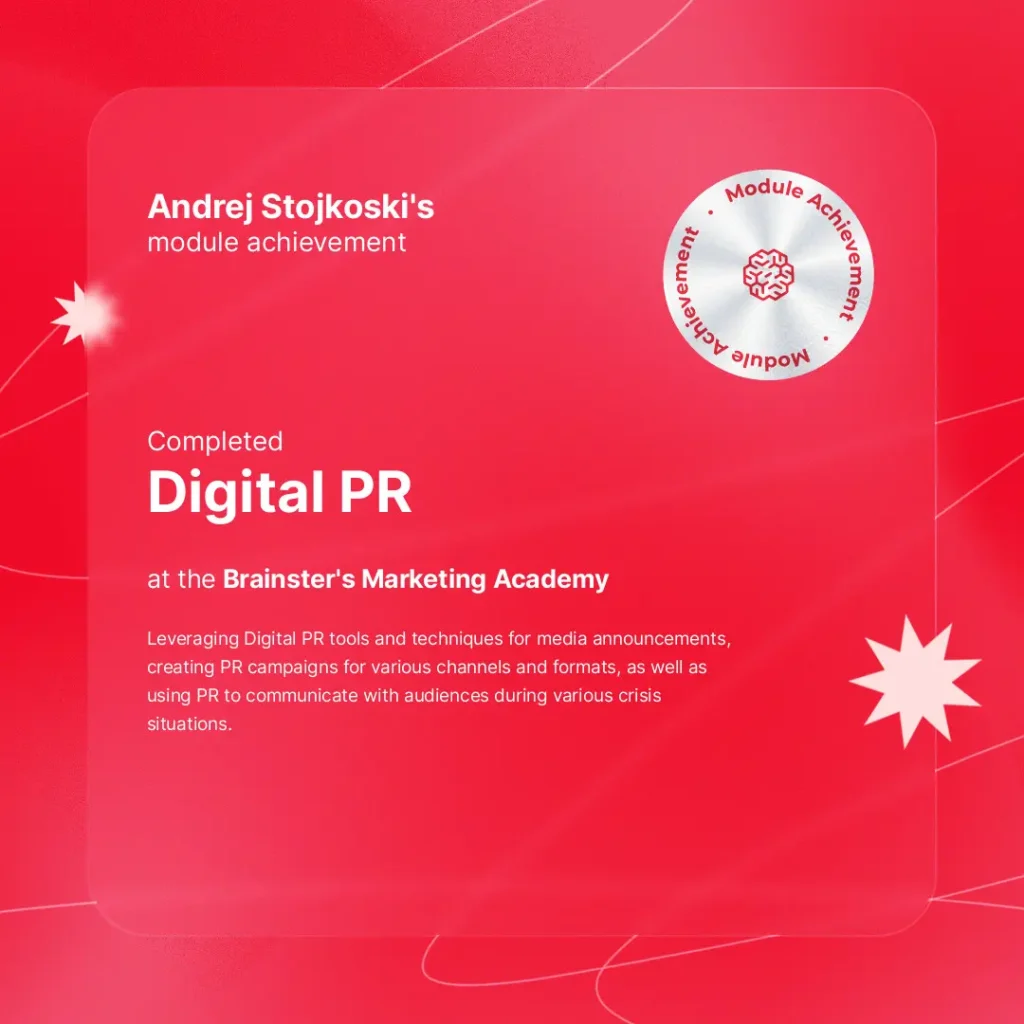From Ads to Reputation: Entering the Strategic World of Digital PR
Following the highly analytical and campaign-driven LinkedIn Advertising module, I transitioned into something more narrative-driven yet deeply strategic—Digital PR. This module, although short in duration, offered some of the most impactful and meaningful lessons about brand perception, online reputation, and the power of storytelling in the digital space.
Over two concentrated weeks, I explored how Digital PR complements paid media efforts by building organic visibility, trust, and long-term credibility—essential components in any brand’s digital ecosystem.
My Expectations for the Digital PR Module
By this point in the Brainster Digital Marketing Academy, I had worked on SEO, social media advertising, and content marketing. But I hadn’t yet explored how brands handle reputation, crises, or corporate responsibility in a digital-first world.
I expected the Digital PR module to teach me how to:
- Differentiate PR from traditional advertising and marketing
- Create digital narratives that influence public perception
- Build PR strategies with Corporate Social Responsibility (CSR) at the core
- Respond to crises with clarity and integrity
- Develop skills in writing press releases and media-oriented communications
This module didn’t just meet these expectations—it tied everything together with strategic depth and ethical grounding.

What I Learned in the Digital PR Module
🔹 Week 1: Foundations of Digital PR and Reputation Building
We began by breaking down the key principles of modern PR and how it differs from marketing or advertising. Core topics included:
- The RPIE process: Research, Planning, Implementation, and Evaluation—a foundational framework for any PR campaign
- Media vs. Community Relations: Learning to engage both internal and external audiences
- Digital PR tools: Using online platforms and earned media to shape public opinion
- PR vs. Advertising: Understanding the nuances between paid placements and earned coverage
We analyzed several successful Digital PR campaigns, dissecting how storytelling, platform choice, and tone of voice shaped public perception.
🔹 Week 2: CSR and Crisis Communication
The second week focused on corporate social responsibility and managing communication during crises—two areas where PR can have a massive impact.
Key learnings included:
- What makes CSR campaigns authentic, not performative
- How reputation management is a continuous process
- Case studies of brands handling crisis situations—what worked and what didn’t
- Writing a press release and outlining a full CSR campaign
We also dove into ethical PR practices—including transparency, social impact, and stakeholder sensitivity—especially during high-stakes situations.
How I Applied the Digital PR Module in Practice
Our challenge project involved creating a full CSR-driven Digital PR campaign for a real client—Mavrovo 365, a brand committed to environmental and social development in a tourist-rich area.
Here’s what I delivered:
- Conducted preliminary research into local community concerns, media trends, and existing CSR efforts in the region
- Developed a PR campaign story centered on eco-tourism and community involvement
- Outlined a CSR initiative that included local partnerships, clean-up actions, and educational workshops
- Created a press release announcing the launch of the initiative
- Built a strategic PR plan using the RPIE model, identifying key communication goals, stakeholder groups, and evaluation methods
The campaign not only reflected real-world community needs, but also demonstrated how Digital PR can reinforce brand loyalty and long-term visibility.
My Experience with the Digital PR Module
Despite being the shortest module, Digital PR packed an incredible amount of value. It taught me how to move beyond campaigns that drive clicks and conversions, into strategies that build emotional equity and long-term brand trust.
Some personal takeaways:
- Crafting a story is just as powerful as a well-placed ad—if not more so
- Ethical communication matters more than ever in today’s fast-moving digital world
- Reputation is an asset, and protecting it requires consistency, honesty, and strategic planning
It also helped me connect the dots between different parts of the digital marketing landscape—PR supports SEO, influences social media engagement, and enhances brand equity over time.
Tools and Concepts I Worked With
Tool/Concept | Purpose |
RPIE Process | Structured PR campaign development |
Media & Community Relations | Building trust through engagement |
CSR Strategy Frameworks | Developing values-based campaigns |
Crisis Communication Plans | Managing brand voice during high-pressure scenarios |
Press Releases | Communicating newsworthy events clearly and professionally |
Top Skills I Gained from the Digital PR Module
✅ Strategic Campaign Planning
Applying the RPIE process to develop thorough PR plans.
✅ Corporate Social Responsibility in Communication
Integrating ethical, community-focused narratives into brand messaging.
✅ Crisis Communication
Planning proactive responses and transparent communication strategies during crises.
✅ Press Release Writing
Structuring official announcements with clarity and professionalism.
✅ Digital Reputation Management
Monitoring and shaping public perception across platforms.
Why Digital PR Is Essential in Modern Marketing
In the digital age, a brand’s reputation is its currency. With audiences expecting transparency and accountability, Digital PR allows companies to communicate authentically, build loyalty, and weather crises with resilience.
Whether it’s through a CSR initiative, a viral PR stunt, or a heartfelt press release, Digital PR ensures brands stay connected to their audiences—for the right reasons.
This module reminded me that while advertising brings attention, PR brings credibility. And in an era where trust is the new gold, that’s invaluable.
Final Thoughts: From Campaigns to Credibility
The Digital PR module was the perfect conclusion to a series of marketing and advertising-focused modules. It reminded me that beyond numbers and impressions lies something more powerful—the public’s perception.
Working with Mavrovo 365 gave me the chance to create a campaign rooted in values and purpose, proving that impactful marketing doesn’t always have to be paid—it just has to be meaningful.
From building Google Ads to writing press releases, I now have a fully rounded digital skill set ready for the modern communications landscape.